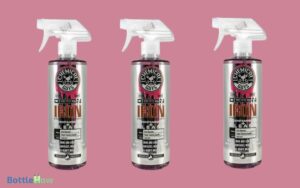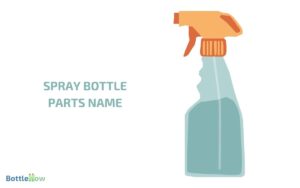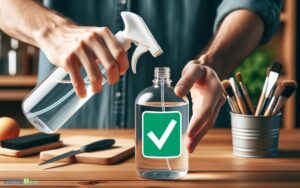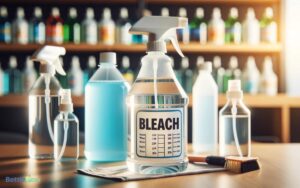Can You Put Acetone in a Spray Bottle? Yes!
You shouldn’t put acetone in a typical plastic spray bottle. Acetone is highly volatile, and flammable, and can degrade many plastics, potentially leading to leaks and chemical contamination. It’s essential to use containers made from materials like glass or metal that are resistant to chemicals.
When using acetone, you must work in well-ventilated areas and wear appropriate personal protective equipment.
For spray applications, consider using safer alternatives like diluted isopropyl alcohol or a vinegar-water solution.
Exploring alternative methods and appropriate containers could greatly enhance safety and effectiveness.
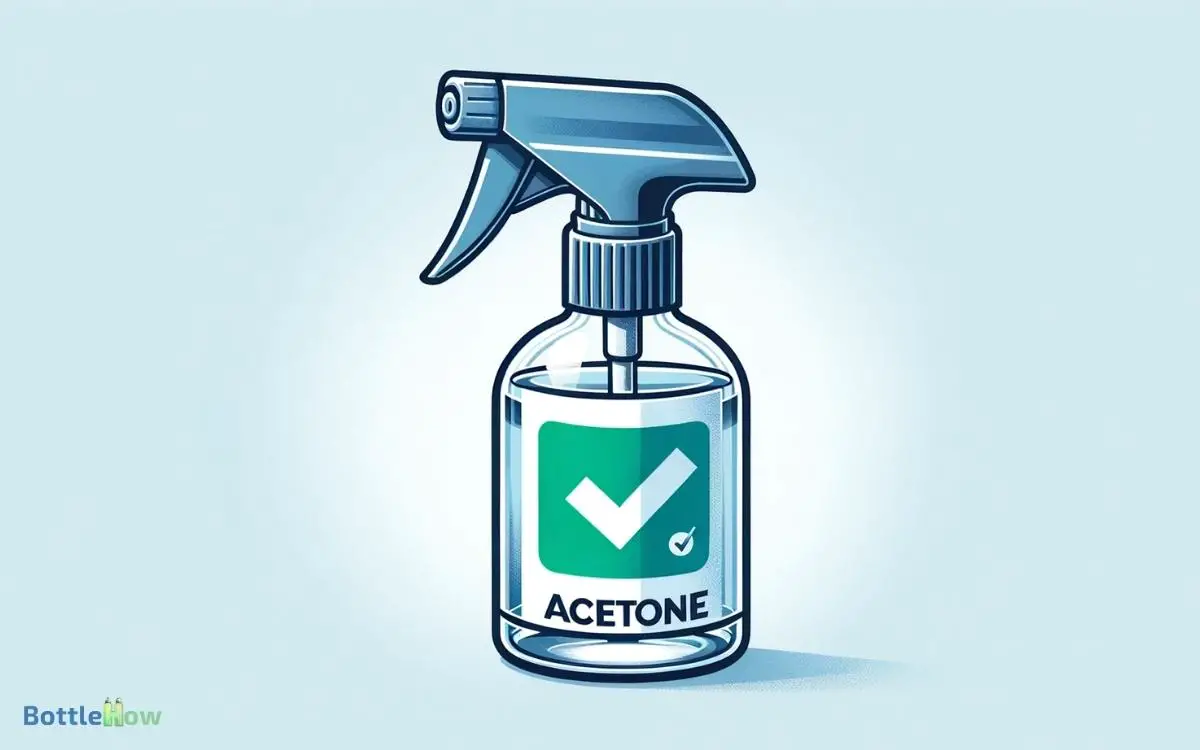
Key Takeaways
Understanding Acetone’s Chemical Nature
Acetone, a highly volatile and flammable solvent, is commonly used in various industrial and household applications due to its effectiveness in breaking down organic compounds.
You’ll find it invaluable in processes like degreasing and cleaning, especially where other agents might fail. Its ability to dissolve plastics, synthetic fibers, and waxes makes it a powerful tool for you if you’re aiming to serve by maintaining or restoring items to their pristine conditions.
However, you must handle acetone with care. It evaporates quickly at room temperature, which can lead to rapid dispersion in your work environment.
Always make sure you’re working in a well-ventilated area to avoid inhaling concentrated fumes, which can be hazardous to your health. Remember, your safety is paramount as you serve others through your work.
Risks of Acetone in Spray Bottles
When you store acetone in a spray bottle, you must consider the potential for chemical degradation of the bottle material, which can lead to leaks and contamination.
Additionally, using a spray mechanism increases your risk of inhaling harmful vapors, posing significant health hazards.
Moreover, acetone is highly flammable, and the fine mist created by spraying can greatly elevate fire safety risks.
Chemical Degradation Risks
You should be aware that storing acetone in a spray bottle can greatly increase the risk of chemical degradation of the bottle’s material. Over time, acetone can weaken certain types of plastic, causing the bottle to crack or leak, which may lead to hazardous spills. It is important to check the compatibility of the container material before storing strong solvents like acetone. If you’re wondering about other substances, you might ask, can you store vinegar in plastic, as some plastics may also degrade when exposed to acidic liquids.
This isn’t just about the bottle losing its shape; it’s about the potential release of harmful chemicals into what you’re spraying.
- Material Breakdown: Acetone can break down plastics not designed for chemical resistance, leading to cracks and leaks.
- Chemical Reaction: Certain spray bottle materials may react with acetone, causing decomposition of the bottle and contamination of its contents.
- Emission of Fumes: As the bottle degrades, it can emit harmful fumes, not from the acetone itself, but from the compromised material of the bottle.
Be cautious and informed when choosing your storage solutions.
Inhalation Hazard Concerns
Spraying acetone from a bottle not only disperses the liquid but also poses significant inhalation risks, potentially harming your respiratory health.
When you use a spray bottle, acetone becomes aerosolized, allowing tiny droplets to be easily inhaled.
This exposure can irritate your nose, throat, and lungs, and with prolonged use, you might experience more severe respiratory issues.
It’s essential to use such chemicals in well-ventilated areas to minimize inhalation. If you’re tasked with using acetone in your workplace or at home, always wear appropriate safety gear like masks or respirators designed for organic vapors.
Remember, your safety is paramount, and understanding these risks can help you protect yourself and others from potential harm.
Fire Safety Issues
Beyond inhalation risks, placing acetone in a spray bottle greatly increases fire hazards due to its highly flammable nature.
When you spray acetone, you disperse fine particles that can ignite from a spark or high heat, posing serious risks.
Here’s what you need to remember:
- Vapor Ignition: Acetone vapors can ignite at a lower temperature than many other chemicals, making even small quantities dangerous.
- Flash Point: Its flash point is -20 degrees Celsius, meaning acetone can catch fire at ambient temperatures found in many environments.
- Accidental Triggering: Simple actions, like flipping a light switch, can generate enough energy to spark a fire if acetone vapors are present.
Always handle with care and prioritize safety protocols to protect yourself and others.
Appropriate Containers for Acetone
When selecting a container for acetone, it’s crucial to choose one that won’t degrade or react with the solvent.
You’ll need to opt for materials like glass or metal, as these are resistant to the corrosive nature of acetone.
Plastics, particularly those categorized under types 3 (PVC) and 6 (PS), are generally unsuitable as they can dissolve or swell upon contact with acetone.
Choosing the right container isn’t just about chemical compatibility; it’s also about ensuring the safety and efficacy of your work.
You should also consider the container’s closure system; it must be secure enough to prevent any leaks or spills, which could be hazardous in your environment. Always prioritize durability and chemical resistance for long-term storage.
Safe Usage Practices for Acetone
When handling acetone in a spray bottle, you must make sure it’s stored in appropriate containers to prevent chemical degradation and leakage.
Always work in a well-ventilated area to avoid inhaling harmful vapors, which can cause respiratory issues and other health problems.
It’s essential to wear the right personal protective equipment, such as gloves and goggles, to protect your skin and eyes from potential irritation or injury.
Appropriate Containers for Acetone
Selecting the right container for storing acetone is crucial, as improper storage can lead to dangerous leaks and chemical reactions.
Here’s a guide to help you choose wisely:
- Material Compatibility: Use containers made from materials that are resistant to acetone. HDPE (high-density polyethylene) or metal containers are usually the best choices. Avoid using PVC, polystyrene, or other plastics that acetone can dissolve.
- Seal Integrity: Make sure the container has a tight-fitting lid to prevent evaporation and leakage. A screw-top lid is typically more reliable than snap-on lids.
- Size and Shape: Opt for containers that are easy to handle and appropriately sized for the amount of acetone you’re storing. This helps prevent spills during use.
Ventilation Requirements
Make sure you use acetone in a well-ventilated area to prevent the accumulation of vapors, which can pose serious health risks. When you’re handling acetone, it’s important to make sure that fresh air can circulate freely.
If you’re indoors, open windows and doors, or use an exhaust fan to help disperse any fumes. This isn’t just for your safety; it protects everyone around you.
Here’s a quick guide to understanding why ventilation is key:
| Requirement | Reason | Benefit |
|---|---|---|
| Open windows | Increases air circulation | Reduces vapor concentration |
| Use exhaust fans | Helps remove contaminated air | Lowers risk of inhalation |
| Keep area clear | Prevents vapor accumulation | Enhances safety for all |
Always remember, taking these steps not only safeguards your health but also shows care for those around you.
Personal Protective Equipment
To guarantee your safety while using acetone, always wear appropriate personal protective equipment (PPE) such as gloves and goggles.
Acetone can be harsh on your skin and eyes, and taking these precautions ensures you’re safeguarded against potential irritation or injury.
Here are three critical pieces of PPE you should use:
- Chemical-resistant gloves: Opt for nitrile or neoprene gloves which offer resistance against acetone’s solvent properties.
- Safety goggles: Make sure they’ve side shields to provide full coverage and protection for your eyes from splashes.
- Respiratory protection: Use a mask with organic vapor cartridges if you’re working in an area that isn’t well-ventilated.
Alternatives to Acetone in Spray Bottles
If you’re looking for a safer alternative to acetone for your spray bottle applications, consider using diluted isopropyl alcohol or a vinegar-water solution. Both options are less aggressive yet effective for various cleaning tasks.
Diluted isopropyl alcohol, typically at a concentration of 70%, is excellent for disinfecting and degreasing without the harshness of acetone. It evaporates quickly, leaving nearly no residue.
Alternatively, a solution of equal parts vinegar and water offers a natural, eco-friendly choice, particularly suitable for cleaning glass or removing mineral deposits. Although slower acting than acetone, it’s much gentler on surfaces and safe around children and pets.
Always label your solutions clearly to make sure they’re used correctly and safely.
Steps for Safely Filling a Spray Bottle
Before you start filling your spray bottle, make sure that the area is well-ventilated and you’re wearing the proper safety gear, such as gloves and goggles.
Here’s how you can proceed safely:
Prepare Your Materials: Gather a clean, acetone-resistant spray bottle and a funnel. Make sure both are dry and free from contaminants to avoid any reactions or dilution.
Pouring Acetone: Using the funnel, carefully pour the acetone into the spray bottle. Pour slowly to prevent splashing, which could be hazardous. Keep the bottle steady to minimize risks.
Secure the Bottle: After filling, tightly close the bottle’s lid to prevent any leaks or vapors from escaping. Store the bottle upright in a cool, dry place away from direct sunlight and heat sources.
Conclusion
To sum up, while it’s tempting to use a spray bottle for acetone, remember it’s not just about convenience. A staggering 90% of plastic bottles aren’t designed to withstand acetone’s corrosive nature, posing serious risks.
Opt for metal containers specifically meant for harsh chemicals. Always prioritize your safety by using gloves and working in a well-ventilated area.
If you must transfer acetone, do so carefully, considering safer alternatives whenever possible to avoid unnecessary hazards.


